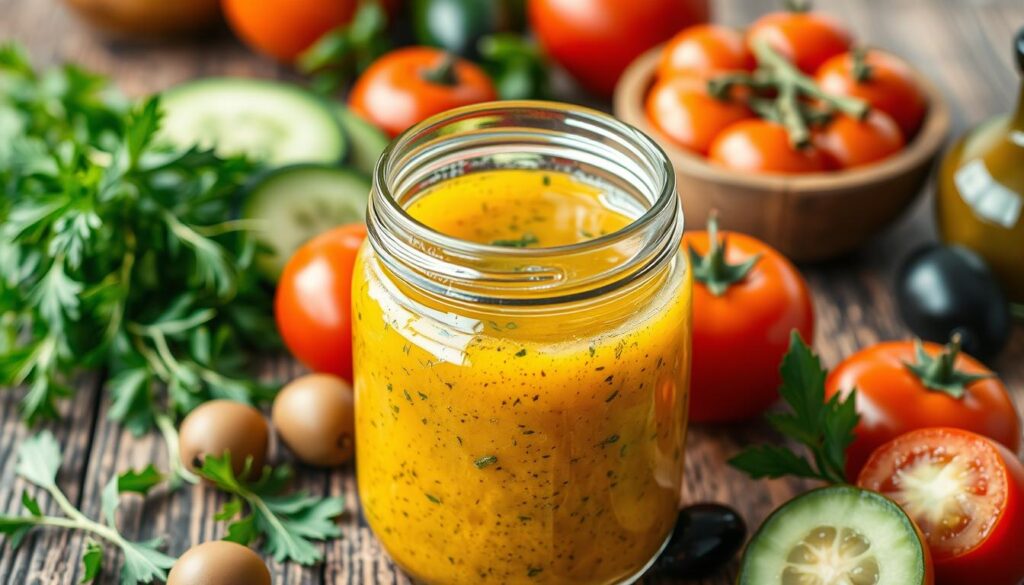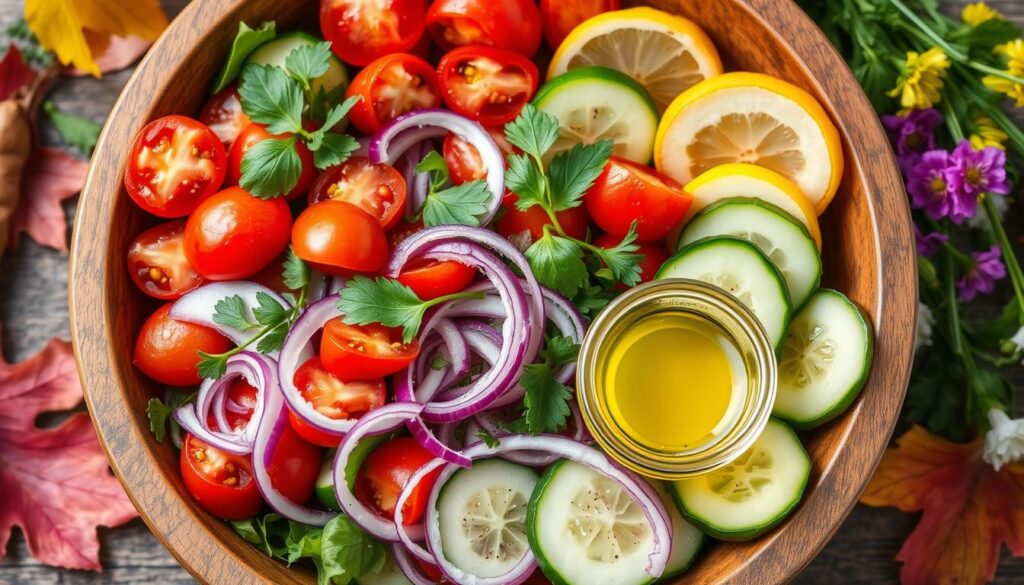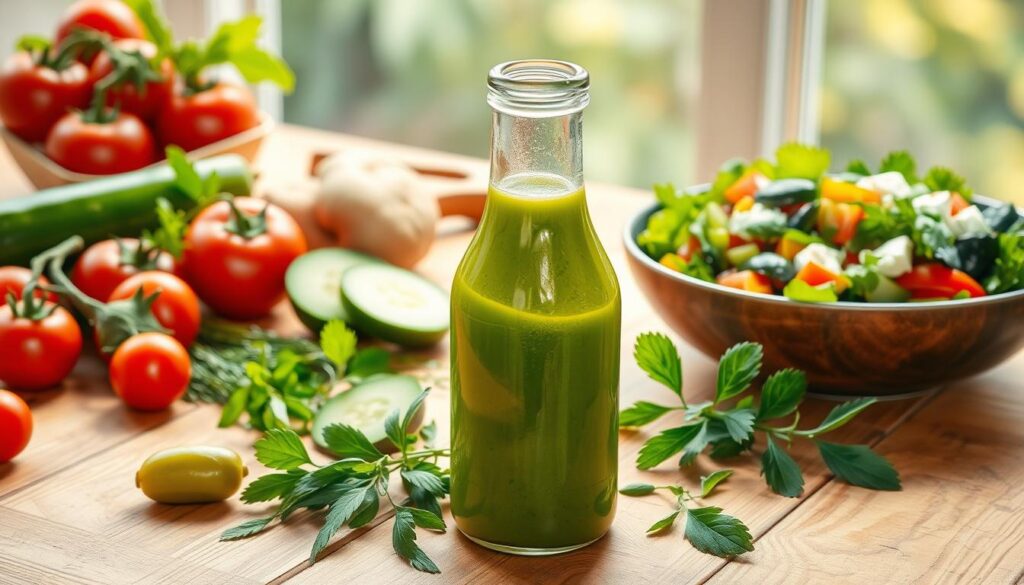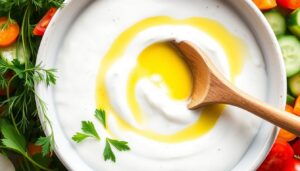I still remember the first time I tasted a delicious Mediterranean salad dressing. It was love at first bite. The mix of flavors in a traditional Greek salad dressing is something I’ve always loved.
As I tried different ingredients, I found the secret to a great dressing. It’s all about balancing the flavors.
My Mediterranean salad dressing recipe has a rich and tangy taste. It’s sure to become a favorite in your kitchen. I’ll show you how to make it, from the ingredients to the steps. Whether you love Greek salad dressing or want a new twist, this recipe is a must-try.
Table of Contents
My Journey to Creating the Perfect Mediterranean Salad Dressing
I remember the day I found the secret to the perfect Mediterranean salad dressing. It was in Greece, where I found a traditional recipe. This recipe changed how I saw salad dressings. The mix of lemon juice and olive oil was key to a perfect balance of flavors.
While trying different ingredients, I learned the olive oil’s quality was crucial. I chose extra virgin olive oil for its richness. The lemon juice added a bright, tangy flavor that contrasted well with the olive oil.
Using a lemon olive oil dressing has many benefits:
- Improved flavor: The lemon and olive oil mix makes any salad taste better.
- Health benefits: Olive oil is full of antioxidants and healthy fats, good for a healthy diet.
- Versatility: This dressing works well on many salads, from classic Greek to modern ones.
Next, I’ll talk about the key ingredients for the perfect Mediterranean salad dressing. We’ll focus on using top-quality olive oil and fresh lemons.
| Ingredient | Quantity | Importance |
|---|---|---|
| Extra Virgin Olive Oil | 1/2 cup | Richness and depth of flavor |
| Fresh Lemon Juice | 2 tablespoons | Brightness and acidity |
| Salt and Pepper | To taste | Enhancing flavors |
Essential Ingredients for Mediterranean Salad Dressing Recipe
To make a true mediterranean salad dressing, you need top-notch ingredients. The base is extra virgin olive oil, fresh lemon juice, garlic, and herbs like oregano and thyme. These give the dressing its unique taste.
Here are the main ingredients to look for:
- Extra virgin olive oil for its rich, smooth texture and flavor
- Freshly squeezed lemon juice for a burst of citrus flavor
- Garlic for added depth and aroma
- Herbs like oregano and thyme for a hint of earthy, herbal notes
A great mediterranean salad dressing recipe comes from mixing these ingredients well. Using fresh, quality ingredients makes a dressing that’s tasty and true to its roots. It goes well with many salads and dishes.
Next, we’ll talk about the importance of extra virgin olive oil in mediterranean salad dressing. We’ll see how it adds richness and flavor.
| Ingredient | Quantity | Importance |
|---|---|---|
| Extra Virgin Olive Oil | 1/2 cup | Base flavor and texture |
| Freshly Squeezed Lemon Juice | 2 tablespoons | Citrus flavor and brightness |
| Garlic | 1 clove | Depth and aroma |
| Herbs (Oregano, Thyme) | 1 teaspoon | Earthy, herbal notes |
The Role of Extra Virgin Olive Oil in Mediterranean Dressings
Choosing the right olive oil is key to making a great olive oil salad dressing. Extra virgin olive oil adds a rich, fruity taste that goes well with other ingredients. It’s important to pick an oil that’s high in quality and the right grade.
Knowing the difference between extra virgin and virgin olive oil helps in making a good choice. The flavor of olive oil can also vary by region. For example, olive oil from Greece tastes different from that of Italy.
Choosing the Right Olive Oil
To make the best olive oil salad dressing, you need a top-notch olive oil. Here are some common types:
- Extra virgin olive oil: known for its rich and fruity flavor
- Virgin olive oil: has a slightly lighter flavor than extra virgin
- Light olive oil: has a neutral flavor and a higher smoke point
Understanding Olive Oil Grades
Olive oil grades depend on acidity level, flavor, and aroma. Extra virgin olive oil, for instance, has low acidity and a rich taste. Knowing these grades helps pick the best olive oil for your dressing.
Fresh Herbs That Make the Difference
Fresh herbs are key to a tasty mediterranean salad dressing. Herbs like parsley, dill, and mint bring a fresh taste. It’s important to use the right amount and chop them finely to unlock their flavors.
For a great dressing, balance the herbs with other ingredients. For instance, mixing parsley with lemon juice and garlic makes a classic taste. Dill with cucumber and yogurt adds a cool twist.
Here are some tips for using fresh herbs in your dressing:
- Choose fresh and fragrant herbs for the best flavor
- Chop the herbs finely to release their oils and flavors
- Balance the flavors of the herbs with other ingredients, such as lemon juice and garlic
By following these tips and trying different herb combinations, you can make a unique and tasty dressing. This will take your salads to the next level.
The Perfect Balance of Acids: Lemon and Vinegar
Creating a tasty Mediterranean salad dressing means getting the acid balance right. A good lemon dressing recipe mixes lemon juice’s brightness with vinegar’s tanginess. Let’s dive into why lemon and vinegar are key in a Mediterranean salad dressing.
Choosing the right vinegar is crucial for a great lemon dressing. Here are some top picks:
- Red wine vinegar
- Apple cider vinegar
Why Fresh Lemon Matters
Fresh lemon juice is vital for a lively flavor in your dressing. Bottled lemon juice can’t match the zest and citrus of real lemons. Always use fresh lemons for the best taste.
Types of Vinegar to Consider
Vinegar choice is also critical for a Mediterranean salad dressing. With many options, picking the right one can be tough. Here’s a table to help you compare some popular vinegars:
| Type of Vinegar | Flavor Profile |
|---|---|
| Red Wine Vinegar | Rich, fruity, and slightly sweet |
| Apple Cider Vinegar | Tangy, slightly sweet, and refreshing |
Knowing the different vinegars and their tastes lets you craft a lemon dressing that suits your taste.
Step-by-Step Instructions for My Mediterranean Salad Dressing
To make my tasty mediterranean salad dressing, start by mixing olive oil, lemon juice, garlic, and herbs in a bowl. Whisk them together until they’re well mixed. Then, add salt and pepper to taste.
This mediterranean salad dressing is ready to use right away or can be stored in the fridge for later. Here’s how to do it:
- Combine 2 tablespoons of olive oil, 1 tablespoon of lemon juice, 1 minced garlic clove, and 1 teaspoon of chopped fresh herbs in a bowl.
- Whisk the ingredients together until they are well combined.
- Season with salt and pepper to taste.
- Store the mediterranean salad dressing in the refrigerator for up to 5 days.
Here is a simple table to help you with the ingredients and their quantities:
| Ingredient | Quantity |
|---|---|
| Olive Oil | 2 tablespoons |
| Lemon Juice | 1 tablespoon |
| Garlic | 1 minced clove |
| Fresh Herbs | 1 teaspoon |
By following these simple steps, you can make your own delicious mediterranean salad dressing. Enjoy it with your favorite salads and dishes.
Mixing Techniques for the Smoothest Dressing
To get the smoothest greek salad dressing, the right mixing technique is key. I focus on the dressing’s texture and consistency. A smooth dressing enhances the salad’s taste and look.
Traditional Whisking Method
The traditional way is whisking ingredients in a bowl until they mix well. It’s simple but might not make the dressing smoothest.
Blender Method
The blender method makes the dressing emulsified and smooth. Blending the ingredients creates a creamy greek salad dressing. It’s great for dressing your salad greens.
Shake-in-Jar Technique
The shake-in-jar method mixes ingredients in a jar by shaking. It’s quick and easy, making a tasty greek salad dressing.
Using any of these techniques, you can make a delicious greek salad dressing. Whether whisking, blending, or shaking, a well-made dressing is always a hit.
Common Mistakes to Avoid When Making Mediterranean Dressing
When making a mediterranean salad dressing, it’s key to avoid common mistakes. Using old or stale herbs can ruin the flavor. This is one of the biggest errors.
Another mistake is not whisking the ingredients well. This can make the dressing uneven. Whisking thoroughly ensures everything mixes well, making a smooth dressing.
Other mistakes to watch out for include:
- Not using fresh lemons, which can make the dressing taste dull
- Not balancing the acids, like lemon juice and vinegar, which can make it too acidic or bland
- Not using good-quality olive oil, a key part of the dressing
To make a great mediterranean salad dressing, avoid these mistakes. Use fresh ingredients, whisk well, and balance the flavors. This will make your dressing delicious and authentic.
Creative Ways to Use Your Mediterranean Dressing
Now that you have your delicious lemon olive oil dressing, it’s time to think outside the box. This versatile dressing is not just for salads. It can also be used as a marinade for grilled meats or as a dip for vegetables.
Beyond Salads: Marinades and Dips
Consider using your lemon olive oil dressing as a marinade for chicken or fish. Or as a dip for pita bread or vegetables. The possibilities are endless, and the flavor is always delicious. You can also use it as a sauce for grilled meats or as a topping for roasted vegetables.
Some ideas for using your lemon olive oil dressing include:
- Marinating chicken or fish for a flavorful and healthy dinner
- Dipping pita bread or vegetables for a tasty snack
- Using it as a sauce for grilled meats or roasted vegetables
Perfect Pairings with Different Dishes
Your lemon olive oil dressing can also be paired with different dishes to add a burst of flavor. Try pairing it with grilled meats, roasted vegetables, or even as a topping for soups or stews. The key is to experiment and find the perfect pairings that work for you.
| Dish | Pairing Idea |
|---|---|
| Grilled Chicken | Lemon Olive Oil Dressing as a marinade |
| Roasted Vegetables | Lemon Olive Oil Dressing as a topping |
| Pita Bread | Lemon Olive Oil Dressing as a dip |
Storage Tips and Shelf Life
To keep your olive oil salad dressing fresh, store it right. Use a glass jar with a tight lid to keep air out. This is key, as high-quality olive oil can spoil easily from light and heat.
Temperature matters a lot when storing your dressing. The fridge is best, as it keeps the dressing cool and fresh for days. Here are some tips:
- Always use a clean and dry glass jar to store your olive oil salad dressing.
- Keep the jar away from direct sunlight and heat sources.
- Store the jar in the refrigerator at a temperature of 40°F (4°C) or below.
By following these tips, your homemade dressing will stay fresh longer. Enjoy it for more days with its great taste and smell.
Proper Container Selection
The right container is crucial for your dressing’s quality and life. A glass jar with a tight lid is best. It keeps air out, preventing spoilage.
Temperature Considerations
Temperature is key when storing your dressing. The fridge is the best place. It keeps the dressing cool, slowing down spoilage and keeping it fresh for days.
| Storage Method | Shelf Life |
|---|---|
| Refrigerator | 5-7 days |
| Freezer | 2-3 months |
Seasonal Variations of My Mediterranean Dressing
I’ve learned to change my mediterranean salad dressing recipe with the seasons. Using ingredients that are in season helps me create a unique taste for each season.
In summer, I add fresh herbs like basil or mint for a bright taste. In winter, I use thyme or rosemary for a warmer flavor.
Here are some seasonal variations to try:
- Summer: Add fresh berries or citrus zest for a burst of flavor.
- Winter: Use roasted vegetables like sweet potatoes or Brussels sprouts for sweetness.
- Spring: Add fresh greens like kale or spinach for a nutritious twist.
By using seasonal ingredients, my mediterranean salad dressing recipe stays exciting. Whether you love fresh herbs or roasted veggies, there’s a version for you.
Health Benefits of Mediterranean Dressing Ingredients
Exploring greek salad dressing reveals its health perks. The Mediterranean diet, rich in olive oil, fruits, and veggies, fights heart disease and some cancers. It’s a diet that’s good for you.
This dressing is packed with antioxidants, which guard against harmful free radicals. It’s also low in calories but full of vitamins and minerals. This makes it a nutritious choice for any meal. Key benefits include:
- Reduced risk of heart disease
- Lower risk of certain types of cancer
- High levels of antioxidants
- Low in calories
- Rich in vitamins and minerals
The Mediterranean diet boosts overall health and wellbeing. Adding greek salad dressing to your meals can bring these benefits to you.
Mediterranean dressing ingredients are a healthy addition to any diet. They offer antioxidants, are low in calories, and are full of vitamins and minerals. This makes greek salad dressing a nutritious way to enhance your meals.
| Ingredient | Health Benefit |
|---|---|
| Olive Oil | Reduced risk of heart disease |
| Fruits and Vegetables | High levels of antioxidants |
| Herbs and Spices | Anti-inflammatory properties |
Conclusion
Reflecting on my journey to make the perfect mediterranean salad dressing, I see the value of quality ingredients and a simple recipe. By mixing extra virgin olive oil, fresh herbs, and acids, you can make a tasty and healthy mediterranean salad dressing.
Some key benefits of this mediterranean salad dressing include:
- Rich in antioxidants and healthy fats
- Can be used as a marinade, dip, or dressing
- Perfect for salads, vegetables, and whole grains
In conclusion, making your own mediterranean salad dressing is easy and rewarding. It can make your meals better and offer health benefits. By using the recipe and tips from this article, you can make a delicious and healthy mediterranean salad dressing for your kitchen.
| Ingredient | Quantity | Benefits |
|---|---|---|
| Extra Virgin Olive Oil | 1/2 cup | Rich in antioxidants and healthy fats |
| Fresh Herbs | 1/4 cup | Adds flavor and freshness |
| Lemon Juice | 2 tablespoons | Provides a balance of acids |
I’m excited to share my simple and flavorful Mediterranean salad dressing recipe. It adds a taste of the Mediterranean to your meals. This dressing is rich and tangy, making it a staple in your kitchen.
This recipe is perfect for those who love Greek salad dressing. I’ll guide you through making this delicious dressing. You’ll learn about the essential ingredients and the step-by-step instructions.
Key Takeaways
- Learn how to make a simple and flavorful Mediterranean salad dressing recipe
- Discover the essential ingredients for a classic Greek salad dressing
- Get step-by-step instructions for creating this delicious dressing
- Understand the importance of using high-quality ingredients in your Mediterranean salad dressing recipe
- Find out how to use your Mediterranean salad dressing in various dishes beyond salads
My Journey to Creating the Perfect Mediterranean Salad Dressing
Thinking back, I remember a traditional Greek recipe that sparked my journey. It combined lemon juice’s brightness with olive oil’s richness. This mix stood out as a perfect balance of flavors.
The secret to this recipe lies in its use of lemon olive oil dressing and olive oil salad dressing. High-quality olive oil and fresh lemons make it both healthy and tasty. Whether it’s a lemon olive oil dressing or an olive oil salad dressing, it always delivers great flavor.
Some standout ingredients in this recipe are:
- Fresh lemons, which add a burst of citrus flavor
- High-quality olive oil, which brings richness and depth
- A mix of herbs and spices, adding complexity and interest
By carefully combining these ingredients, I’ve crafted a lemon olive oil dressing perfect for salads and marinades. Its olive oil salad dressing base ensures it’s a healthy, delicious addition to any meal.

My quest for the perfect Mediterranean salad dressing has been fulfilling. Through trial and error, I’ve made a recipe that’s both healthy and flavorful. Its unique flavor blend is sure to please anyone who tries it.
Essential Ingredients for Mediterranean Salad Dressing Recipe
Creating an authentic mediterranean salad dressing starts with the right ingredients. High-quality olive oil, fresh lemon juice, garlic, and herbs like oregano and thyme are key. These ingredients form the base of the dressing’s flavor.
A balanced flavor is crucial in any mediterranean salad dressing. To get this right, mix the following:
- Extra virgin olive oil for its rich, smooth texture
- Freshly squeezed lemon juice for a burst of citrus flavor
- Minced garlic for added depth and aroma
- Chopped fresh herbs like oregano and thyme for a hint of earthy flavor
Using these ingredients in your mediterranean salad dressing recipe will make a delicious dressing. It’s great for salads, veggies, and more.
For a fantastic mediterranean salad dressing, choose top-notch ingredients and balance the flavors. With a bit of practice, you’ll make a dressing that wows everyone.
The Role of Extra Virgin Olive Oil in Mediterranean Dressings
Choosing the right olive oil is key to a great salad dressing. Extra virgin olive oil adds a rich, fruity taste that enhances other flavors. I always pick high-quality extra virgin olive oil for the best taste.
When picking olive oil, I look at quality and grade. Knowing the difference between extra virgin and virgin helps me decide. I also consider where the olive oil comes from, as it can change the flavor.
Choosing the Right Olive Oil
Here are some top picks for olive oil salad dressing:
- Extra virgin olive oil from Greece or Italy
- Virgin olive oil from Spain or Portugal
- Light olive oil for a milder taste
Understanding Olive Oil Grades
Olive oil grades depend on acidity and how it’s made. Extra virgin olive oil has low acidity and is cold-pressed. Virgin olive oil has a bit more acidity and might be refined too.
Regional Olive Oil Variations
Olive oil from different places tastes different. For instance, Greek olive oil is often bolder than Italian. I pick an olive oil that fits with my dressing’s flavors for a unique taste.
| Olive Oil Type | Acidity Level | Production Process |
|---|---|---|
| Extra Virgin | Low | Cold-pressing |
| Virgin | Medium | Cold-pressing and refining |
| Light | High | Refining |
Fresh Herbs That Make the Difference
Fresh herbs are key to a tasty mediterranean salad dressing recipe. Parsley, dill, and mint bring a bright, refreshing taste. Mixing them with other ingredients creates a unique flavor.
To enhance fresh herbs, pick the right amount and chop them finely. This releases their flavors and oils. Here are some tips for using fresh herbs in your mediterranean salad dressing recipe:
- Choose fresh and fragrant herbs for the best flavor
- Chop herbs finely to release their flavors and oils
- Use a combination of herbs to create a unique flavor profile
A well-made mediterranean salad dressing recipe can make any salad or dish better. Adding fresh herbs gives a delicious, refreshing taste.
Finding the right balance of flavors is key to a great mediterranean salad dressing recipe. Fresh herbs are essential for this balance. By trying different herbs and flavors, you can make a unique mediterranean salad dressing recipe.
| Herb | Flavor Profile | Usage |
|---|---|---|
| Parsley | Bright and fresh | Chop finely and add to dressing |
| Dill | Slightly sweet and tangy | Use in combination with other herbs |
| Mint | Cool and refreshing | Chop finely and add to dressing |
The Perfect Balance of Acids: Lemon and Vinegar
Creating a tasty Mediterranean salad dressing means getting the acid balance right. A great lemon dressing recipe mixes lemon juice’s brightness with vinegar’s tang. Fresh lemon juice is key for a lively flavor.
The choice of vinegar is also important. You can use red wine vinegar or apple cider vinegar. Here’s what to think about when picking a vinegar:
Types of Vinegar to Consider
- Red wine vinegar: adds a rich, fruity flavor
- Apple cider vinegar: provides a slightly sweet and tangy taste
Why Fresh Lemon Matters
Fresh lemon juice is essential in a good lemon dressing. It brings a bright, citrusy taste that bottled juice can’t match. Using real lemons makes your dressing more vibrant and lively.
By balancing acids in your lemon dressing, you make a tasty Mediterranean salad dressing. It will make any dish better.
| Vinegar Type | Flavor Profile |
|---|---|
| Red Wine Vinegar | Rich, Fruity |
| Apple Cider Vinegar | Slightly Sweet, Tangy |
Step-by-Step Instructions for My Mediterranean Salad Dressing
To make my tasty mediterranean salad dressing, start by mixing olive oil, lemon juice, garlic, and herbs in a bowl. Whisk them together until they’re well mixed. Then, add salt and pepper to taste.
This mediterranean salad dressing is ready to use right away or can be stored in the fridge for later. Here’s how to do it:
- Combine 2 tablespoons of olive oil, 1 tablespoon of lemon juice, 1 minced garlic clove, and 1 teaspoon of chopped fresh herbs in a bowl.
- Whisk the ingredients together until they are well combined.
- Season with salt and pepper to taste.
- Store the mediterranean salad dressing in the refrigerator for up to 5 days.
Some tips for making this mediterranean salad dressing include using top-notch ingredients. Choose extra virgin olive oil and fresh lemons. Also, adjust the garlic and herbs to your liking.

By following these easy steps, you can make a delicious and healthy mediterranean salad dressing. Enjoy it with your favorite salads and dishes.
| Ingredient | Quantity |
|---|---|
| Olive Oil | 2 tablespoons |
| Lemon Juice | 1 tablespoon |
| Garlic | 1 minced clove |
| Fresh Herbs | 1 teaspoon |
Mixing Techniques for the Smoothest Dressing
To make the perfect greek salad dressing, the right mixing techniques are key. I use a few methods to get the smoothest texture. The goal is to mix the ingredients in a way that enhances flavors and textures.
I start by whisking the ingredients together in a bowl. This traditional method is simple and works well. It lets me control the dressing’s consistency. For a smoother texture, I might blend the ingredients. This is great for making a big batch of dressing.
Alternative Mixing Methods
Another way is the shake-in-jar technique. I shake the ingredients in a jar until they mix well. This method is quick and easy, perfect when I’m in a rush. Here are the benefits of each method:
- Traditional whisking method: easy to control consistency, simple to use
- Blender method: creates a smooth, emulsified texture, ideal for large batches
- Shake-in-jar technique: convenient, easy to use, and great for small batches
Choosing the right mixing technique helps me make a delicious, smooth greek salad dressing. Whether I whisk, blend, or shake, the result is always tasty and refreshing.
Common Mistakes to Avoid When Making Mediterranean Dressing
When making a mediterranean salad dressing, it’s key to avoid common mistakes. Using low-quality ingredients, like old herbs, can ruin the flavor. This is a major error.
Another mistake is not whisking the ingredients well. This can lead to a dressing that’s not smooth. To fix this, whisk everything in a big bowl until it’s smooth. This makes sure your dressing tastes great every time.
Other mistakes to watch out for include:
- Not using fresh lemons, which can make the dressing taste dull
- Not balancing the acids, like lemon and vinegar, which can make it too sour or bland
- Not storing the dressing right, which can cause it to spoil or separate
To make a tasty mediterranean salad dressing, avoid these mistakes. Always choose the best ingredients and whisk them well. This way, your dressing will be smooth and delicious, perfect for your salads and more.
Creative Ways to Use Your Mediterranean Dressing
I’ve found that my Mediterranean salad dressing is great for more than just salads. The mix of lemon and olive oil is perfect for many dishes. It’s amazing as a marinade for grilled meats or as a dip for veggies.
Using it as a marinade for chicken or fish adds a lot of flavor. Just mix it with garlic and herbs for a tasty marinade. It’s also great as a dip for pita bread or veggies, making for a tasty snack or appetizer.
Beyond Salads: Marinades and Dips
- Marinade for grilled meats: Mix the dressing with garlic and herbs for a flavorful marinade.
- Dip for vegetables: Use the dressing as a dip for raw or roasted vegetables.
- Dip for pita bread: Serve the dressing as a dip for pita bread or crackers.
Perfect Pairings with Different Dishes
The lemon olive oil dressing is also great with other dishes. Try it with grilled meats, roasted veggies, or as a pasta sauce. There are so many ways to use it, and I’m excited to keep finding new ones.
Storage Tips and Shelf Life
To keep your olive oil salad dressing fresh, proper storage is key. Use a glass jar with a tight lid. This keeps air out and prevents rancidity.
Here are some tips for storing your olive oil salad dressing:
- Store it in the fridge for a steady temperature.
- Use an airtight container to avoid contamination.
- Mark the container with the date made for tracking.
By storing your olive oil salad dressing right, you can enjoy it for days. Always check for spoilage before using.
Seasonal Variations of My Mediterranean Dressing
I’ve learned that changing my mediterranean salad dressing recipe with the seasons is key. Using ingredients that are in season adds a special flavor to the dressing.
In summer, I add fresh herbs like basil or mint for a bright taste. Winter calls for heartier herbs like thyme or rosemary for a deeper flavor.
Here are some other seasonal twists I’ve tried:
- Roasted garlic in fall for a rich, nutty taste
- Fresh orange juice in spring for a citrusy burst
- Diced apples or pears in winter for a sweet crunch
These changes keep my dressing exciting, even after making it many times. By trying new ingredients and flavors, I’ve made a dressing that’s great all year round.

Health Benefits of Mediterranean Dressing Ingredients
Exploring greek salad dressing reveals its health perks. The Mediterranean diet, rich in olive oil, fruits, and veggies, lowers heart disease and cancer risks. It’s a diet that’s good for you.
Greek salad dressing is packed with antioxidants. These protect your body from harm. It’s also low in calories and full of vitamins and minerals. This makes it a great addition to any meal.
- Vitamin C: important for immune function and collagen production
- Vitamin E: acts as an antioxidant, protecting cells from damage
- Monounsaturated fats: help lower total cholesterol and LDL (“bad”) cholesterol
Adding greek salad dressing to your meals can boost your health. Its rich taste and health benefits make it a favorite in Mediterranean homes.
Nutritional Profile
A 2-tablespoon serving of greek salad dressing has about 170 calories. It has 19g of fat and 2g of carbs. It’s also a good source of vitamin K, vitamin C, and calcium.
Mediterranean Diet Connection
The Mediterranean diet, which includes greek salad dressing, offers many health benefits. It can lower heart disease, type 2 diabetes, and cancer risks. Adding greek salad dressing to your meals can make your diet healthier and tastier.
Conclusion
As we wrap up our exploration of making the perfect Mediterranean salad dressing, I hope you’re excited to try it for yourself. This homemade dressing not only elevates your salads but also works as a marinade or dip, bringing bold Mediterranean flavors to various dishes.
The key to a standout dressing lies in high-quality ingredients—extra virgin olive oil, zesty lemon, and fragrant herbs. These elements create a dressing that is both nutritious and packed with flavor. Achieving the right balance takes patience, but the results are worth it.
Don’t be afraid to experiment with variations to make it your own. The beauty of Mediterranean dressing is its versatility—it complements a wide range of foods and dietary preferences.
Embrace the Mediterranean way of cooking with this simple yet delicious dressing. Making it from scratch is not only rewarding but also a step toward healthier, flavor-packed meals.
Reviewed by Koujil Amine, founder of YummyWhirl, and generated by Emma Chef.



